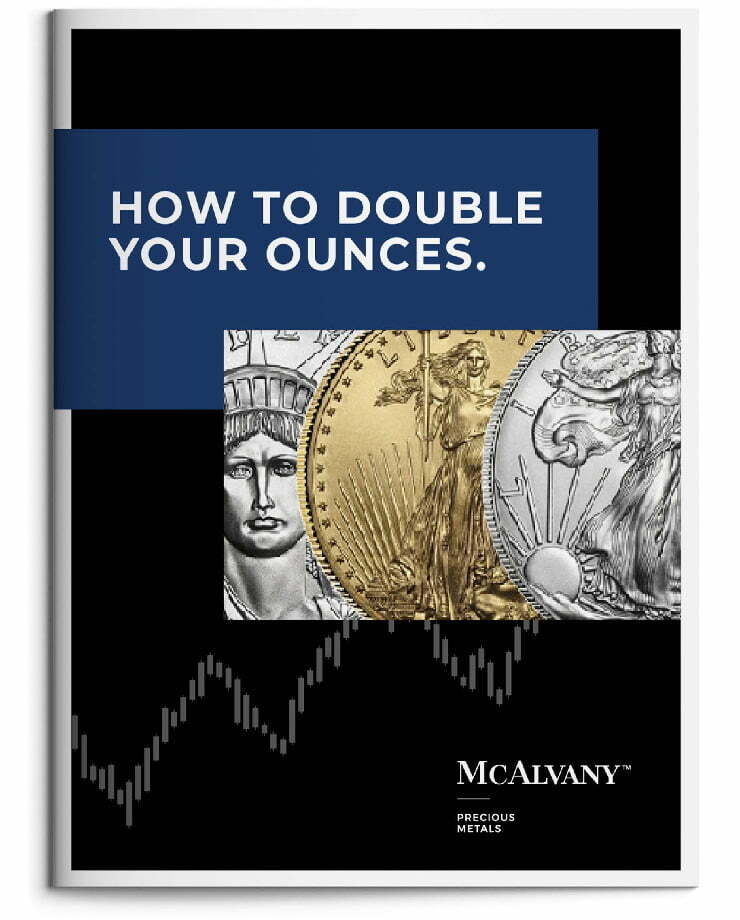Podcast: Play in new window
- Central Bankers Are No Longer Considered Guardians Of The Galaxy
- National Debt Ballooning At Almost $100 Billion Per Week
- Learn About The Hard Asset Difference - Sign Up For The Webinar
“We are not tiptoeing towards bankruptcy. We’re in a dead sprint, like sprint to the finish. Only the prize is failure, and the finish line is an economic flat line. There’s some controversy over the $106 billion that’s being asked for to finish the wall, to fund Ukraine, to fund Israel, as if that’s a big ask. That’s a week’s worth of deficit spending at the current rate. In the year’s time, it’s a rounding error. We’re going to pass 34 trillion by the end of November. This math is terrifying, and it’s not easy to resolve. The ways that we could: 40% increase in taxes across the board, 35% cut to all spending. Or with less than half the current level of debt, even at that point, the estimates were: you need double digit economic growth rates every year uninterrupted for the next 50 years.” —David McAlvany.
Kevin: Welcome to the McAlvany Weekly Commentary. I’m Kevin Orrick, along with David McAlvany.
You were on a call yesterday, Dave, that we were talking about last night, and this person who had heard you on an interview said, “I heard you twice, and when I heard you say this is a good time to own hard assets,” he said it finally made sense. It made sense. Sometimes we just need to sit down and say, “All right, the news is confusing right now. We’ve got a lot of different inputs. What’s something that we can say that we can really just stick to no matter what the propaganda is saying?” I think that’s one of those. This is a good time to own hard assets.
David: Absolutely. And certainly with war and rumors of war and concerns in the Middle East, we already know that truth is the first casualty of war. So sorting out the melee of information, what’s going on, it is remarkable how sometimes simple statements resonate and mean something.
Kevin: Well, and tied to that statement, you’ve got a team of people that— I was talking to my son this weekend. We were out on a mountain bike ride, and I said, “Do you realize, on Tuesday mornings we get one of the best economic analyses that you can get anywhere in the nation, just in our Tuesday meeting?”
David: Regular morning meeting.
Kevin: But you’ve got this team, you’ve got Morgan, you’ve got Robert—
David: Doug, Robert, Philip.
Kevin: Doug. Yeah, and most people can’t hear them, on a regular basis, speak, but coming up Thursday—
David: Join us this Thursday, 10:00 AM Mountain, conference call with our wealth management team. We’ll explore the advantages of a hard asset portfolio. Register today, you can link to the show notes or go to mcalvany.com/wealth, and our focus on a broadly diversified portfolio of hard asset related companies is worth considering.
Kevin: Something that you said one time—and I love the way it explains what you do—it’s like: we like to invest in things that if you were walking around in the dark, you would trip over them. So we’re not talking about just financial ideas.
David: No. Stuff you can stub your toe on. If you have the sense that we’re already in a new cycle and that risks are being minimized or ignored by your current asset manager with a focus like everyone else’s on the same themes that worked yesterday, you should probably join us. If your current portfolio is merely a professional expression of fear of missing out, or you’re still stuck in a 60/40 mix of stocks and bonds as some sort of an expression of hope, you should probably join us.
Kevin: So often I talk to a client who’s got just a normal broker, and they’ll say, “I told him I don’t want stocks right now, and he’s like, ‘Well, then we’ll put you into bonds.’” Or, “I don’t want to buy debt right now.” “Well, we’ll put you into stocks.” It’s not very imaginative.
David: No, and the difference in this environment is the difference between second-degree burns and third-degree burns. It’s like, well, yes, one is better than the other. If you register for the call today, join us Thursday morning, you’ll have an informative presentation on the merits of hard assets—and this is hard assets beyond, but also including, precious metals, with a healthy income component and management team with a track record of managing risk and identifying compelling reward within that space. So, making money throughout the global financial crisis, we check that box. Avoiding losses in 2022, check that box.
Kevin: And if a person is saying, “Well, how do I do that?” Just go to mcalvany.com/wealth. Mcalvany.com/wealth, and it’s free. Dave, this is sort of a condensed version of what you gave the clients who flew in. Three weeks ago you were doing a conference.
David: Except that we can’t fit five hours precisely into the 90 minutes. That’s more than—
Kevin: How are you going to do that?
David: I don’t know.
Kevin: How are going to do that?
David: We’ll see. But if you just think, okay, it’s worked so far, but I don’t think it’s going to work going forward, this autopilot investing. And the number of people we run into who are on target date funds that frankly are not on target—or, look, if that grouping of investments has an intrigue to you, global natural resources, a broad array of infrastructure companies, precious metals miners, and specialty real estate exposures.
Kevin: When I walk through the hallway of McAlvany Wealth Management, when I come back sometimes to just say something to you, if you’re on a meeting with these guys— Mondays and Wednesdays you have meetings that sometimes sound like arguments. I mean, you guys are doing analysis from the top down and the bottom up, and you don’t always agree—which, I love that. Iron sharpening iron is sometimes the best way to come to a truth.
David: We have hours every Monday, every Wednesday, and it’s how we marry macroeconomic top-down risk analysis with company-specific micro fundamental bottom-up opportunity assessments.
Kevin: Details. Yeah.
David: What in our weekly routine and process happens is we discuss the signals that matter to us, gauging just what the market landscape is changing and morphing into. So who’s on the team, what you should expect from a professional asset manager. This is an opportunity, I think, for you to expand beyond the basic pie chart allocation. If that’s what you’re used to, the delegation of actual investment to dozens of fee-heavy third party mutual fund managers and blind ETF baskets, I think you’ll be intrigued by the whole team.
Kevin: When I was on this mountain bike ride talking to my son, I mean, he grew up with the company. Let’s face it. He’s here now, but he grew up around McAlvany, Don McAlvany, and then you, and I told him what’s nice about the analysis that you do hear on Tuesdays and that everyone will be able to hear on Thursday if they want to tune in is, it’s not just economics. There are a lot of guys who get their PhD in economics, and they love a particular mathematical system, but they have no ideology. They don’t live for a greater myth or a greater story or a greater understanding of what is true. That’s not the case with this team. This is a team that actually has a worldview perspective and then uses economics to try to make things happen.
David: Without a framework, without disciplines, without processes, you find that there’s very little that can get done, but with a framework, with disciplines, with processes, it’s amazing how much progress can be made. And the world is still full of unknowns, but that’s why you have to have framework, disciplines, and processes to be able to react and respond in real time, and that’s why it is a process where you roll up your sleeves, you get your hands dirty every day. The team makes decisions. It is critical analysis, thoughtful discussion, debate, as you talked earlier. It’s hard work. And I started with Morgan Stanley 20 something years ago, and I remember the number of guys that I worked with who didn’t know a whole lot, but they could parrot the Wall Street Journal pretty well. Surprisingly, that’s what most investors settle for. Real analysis, real things, hard assets. They make sense in the environment we’re entering. So Thursday at 10:00, register, we look forward to having you on the call.
Kevin: One of the difficulties in life actually is that we don’t really live through too many long cycles. I think about it, Dave, I graduated in 1981 from high school. My wife and I bought our first house in 1983. Interest rates were peaking at that time, and I have enjoyed, honestly, an entire adult life of falling interest rates, where even our government could continue to go further and further into debt and know it was paying less and less interest every time. You have to take into account that maybe that cycle has changed at this point. That’s a difficulty because very few of us have any experience before that time.
David: There’s all kinds of cycles. They’re around us and we engage with them every day. Our own sleep cycles, we tend not to think about them. We just kind of accept that this is reality. And so to be able to be sort of removed from the stream of events and see cycles from a longer-term perspective, sometimes we miss the repetition or even the value of what is changing. From a conversation earlier this week, we bought our first house in 1981. The mortgage rate was just over 17%.
Kevin: I remember those days.
David: And this gentleman said, “We survived, and over time things got a lot easier. Rates came down, prices went up.” As I listened on the other end of the phone, I kept seeing a generation that has experienced a lot, but still may not know how to make sense of the current landscape and the changes. The signposts are there for the reading, but it is sometimes difficult to know how far along the path you are. It’s not easy, but here we see in the interest rate market, a trend has shifted, and the case emerging is that rates, after a long secular decline, 40 plus years—complimented by monetary policy accommodations, complimented by faith in Fed powers, complimented by the opportunity to refinance accumulated debts at lower numbers time after time after time, the cases emerging—that that’s now working in reverse. The implications are huge at every level for corporates, for households, for governments. You’re talking about increased operational costs, diminishing asset values, and this is something where, again, if you’re not following the cycles, if you don’t understand the circadian rhythms, you might miss that something has just changed.
Kevin: I remember 8-track tapes. I don’t know if you go back far enough to remember 8-track tapes, but remember, you would put the 8-track tape in and it was a cool thing to have an 8-track player in your car.
David: The last one that we had was in our yellow Scout. Okay. Do you remember Scouts?
Kevin: Oh, yeah, of course. Yeah.
David: Well, in the early days of the gold business, Molly would deliver packages to the post office, gold and silver in the yellow Scout.
Kevin: In the yellow Scout, listening to 8-track tapes.
David: Listening to 8-track tapes, and in the front seat was Sheeba. Sheeba was our German Shepherd—
Kevin: German Shepherd. I remember Sheeba.
David: Oh, yeah.
Kevin: Oh, yeah.
David: Pretty intense security at that point.
Kevin: Okay, so just go back with me for just a bit because we’re talking about older times. Eight-track tapes, there was this delay. You might be listening to the favorite part of your song and then it fades, and then there’s this dead spot while it changes tracks, Neil Diamond or whatever. Then it comes back and picks up where it left off, but there’s this delay, and I think about the cycle that we have gone through, Dave, we’re talking early ’80s where interest rates have fallen. They fell for 40 years, but I actually wonder if the cycle, if it wasn’t like an 8-track tape and monetary policy gave us that gap, that blank—
David: The delay.
Kevin: Yeah, because remember in 2011, everything was falling apart and Mario Draghi came out and he spoke for all central bankers around the world. He said—
David: “We’ll do whatever it takes.”
Kevin: And they bought an extra, what, 10 or 12 years.
David: They did.
Kevin: It’s that gap, but the cycle now changes.
David: To me, monetary policy is about as broken as the Fed’s reputation. The Wizard of Oz moment has already occurred. The wizard is not a wizard. He’s just a man. And control—the illusion, the magic—is now understood to be make-believe. Zero rates seemed to alter—seemed, past tense, to alter the universe for a time, but the illusion’s faded. Influencing perceptions, getting out and speaking to the public and saying, “Oh, this is what we’re going to do next.” Forward guidance. Creating perceptions. Deceptions. It’s run its course.
Monetary policy, while it has passed on financial benefits over the last 30 or 40 years, is now having some struggles of its own. Refinancing at lower and lower numbers was the benefit. And this held true for corporates. It held true for households. It held true for governments. Anybody with a slug of debt has benefited from the last 40 years, and we take it for granted. Easing the burden of debt and allowing us to go from 30% debt-to-GDP in the 1970s without a hitch to 120% today. Reinhart and Rogoff said the wheels start to come off at 90. Well, why haven’t they? In part because the central bank community has decided to artificially hold rates below a natural level. So we sit on top of a mountain of obligations 36 times larger than it was in the 1970s, and the math worked as long as refinancing at lower rates was an option. The math is unmanageable if rates move the other way. That’s the unfolding story. The slow motion train wreck. Debt has given us more growth faster. But do you remember Lou Ferrigno, the actor who played The Incredible Hulk?
Kevin: Yeah, he was amazingly large, and then it was amazingly tragic the way he ended.
David: Well, unnatural use of steroids to promote unnatural growth leads to unfortunate outcomes, and that’s essentially what we’ve done in the debt markets. Unnatural growth, unnatural means, and we’re on the cusp of unfortunate outcomes.
Kevin: I have enjoyed the fact that interest rates have fallen. Now, we started way into too much debt when we first got married. My wife’s mantra was that we needed to build our credit. Well, that was a mistake. We built our debt, is what we did. We didn’t build our credit. But you think about that, think about people who can look back to the early eighties and say, “Okay, our economic experience, and frankly the economic experience of just about every money manager, has been in this falling rate environment.” I was bringing up the metaphor of a tape, but back in the sixties and seventies, it was popular to record something backwards. You remember the groups that would record something backwards? “Another One Bites the Dust,” but if you—
David: Back mask.
Kevin: Yeah. But what happens when we back that tape up?
David: Well, and that’s the couple starting with the 17% mortgage. Mary Catherine and I were seven point a half percent in our first home. We refinanced at five and a half and then three and a quarter. It’s been an interesting ride, and it’s helped, of course. So 17% mortgage experienced relief, that couple did, over time as mortgage rates dropped and they received the double blessing of lower cash outflows and an increased balance sheet as the value of their home increased. That’s what happens. Lower rates, higher values. As hard as it was to swallow 17%, 13% seemed like a gift. So did nine and six and five, but you’re right. Play the tape in reverse and you have increased cash flow pressures and a shrinking balance sheet, and that’s just begun for corporates, for households, and for governments.
Kevin: So, “Another One Bites the Dust,” only played backwards. But the anomalies that we’ve seen at the end of this cycle, because we have changed, we have changed to a different cycle.
David: Is that Freddie Mercury?
Kevin: Yeah. Yeah.
David: There was a guy walking down the street the other day, and I swear, it was like, he’s back.
Kevin: Right here in Durango.
David: It was amazing. It was amazing. I’m like, “That was a choice.” Boy, what an artistic band. Anyways.
Kevin: Well, okay, so we were sitting right here five years ago saying, “This isn’t real.” We had negative interest rates for the first time in what, four or five thousand years, and literally people were putting a hundred thousand dollars into an account and getting 99-something back and saying, “Hey, that’s pretty darn good interest.”
David: Or if you were bold, you went to Argentina for a hundred-year bond that was paying between 7 and 8%, and guess what? Today your hundred-year bond is worth less than half its original value.
Kevin: Wow.
David: That’s not including the inflation piece, of course. That’s just on the loss because of a rise in interest rates.
Kevin: So let me ask, though, if we hit a 4,000-year record of low interest rates at the end of this particular bond cycle, what’s normal for bonds?
David: Yeah, and that’s what’s really interesting to me. Bond yields have been much higher than they are today. I mean, never with this quantity of debt. They’ve been much lower, as we all know. We’re coming off of 4,000-year lows in yields. Reciprocally, if you’re looking at the other side of that, 4,000-year highs for the price of those bonds, with extraordinarily low yields. And price has begun to revert to something that’s simply less extraordinary, but it’s more normal at 5%, and everyone is searching for the peak in yields. They desperately want 5% to be that number on the 10-year so that we can go back to the “better days.” When I started my career on Wall Street over two decades ago, tax-free municipal bonds were over 6%, 6½%. That’s with a tax equivalent yield of over 9. These are GO, general obligation, AAA, insured by Ambac or MBIA. I bought a lot of bonds for clients 23 years ago.
Kevin: And that was more normal.
David: The 10-year treasury spent the decades of the eighties, nineties, early two thousands, up to 2008, over 5%, 98% of the time. The extraordinary period, the anomaly was from 2008 to 2020 where extraordinary monetary policy experimentation brought rates to nearly zero in real terms, deeply negative. The 10-year at 52 basis points was a record low. So now you have investors hoping that 5% is the peak in rates. Hoping. That’s their strategy. That’s how they’re trading. And it reminds me of a 17th century Scottish proverb. If wishes were horses, beggars would ride.
Kevin: So let’s put this in perspective because during our lifetimes, the government bond has been one of the safe places to be, and you have to look at interest rates like a teeter totter, interest rates on one side and the value of a bond or the price of a bond on the other side of the teeter-totter. If interest rates fall, the value of bonds goes up. If interest rates rise, the value of bonds go down. Now, the further you are out on that teeter-totter, let’s say 10-year, 20-year, 30-year bonds, the 30-year’s way out on the edge. 30-year bonds were still considered a stalwart, a strong investment. How much have people lost in the last couple of years in 30-year bonds?
David: Well, again, this comes back to the idea of cycles, long cycles, and what you lose without understanding kind of where you’re at in the stream of things. During a bond cycle, you have bonds going from extraordinarily safe to the recurring reference of “certificates of confiscation.” So how can the same instrument be the safest investment on the planet at one end of the spectrum and a certificate of confiscation on the other? That’s what happens throughout the full course from a bull market in bonds to a bear market in bonds. And so the certificates of confiscation, that’s what we are moving towards. Where are we at so far, off of those extraordinary low levels in 2020? Extraordinary high prices. Fixed income investors have been suffering through a period of angst in what is essentially— Again, they’re thinking bear market, this is as bad as it gets. All this is is a normalization process. Yes, a bear market in bonds, which has seen the long bond investor down between 40 and 50%.
Kevin: That’s huge.
David: That’s a significant loss in three years. It’s been painful. Bond prices have collapsed. The farther you go out on the curve, as you mentioned, the harder it gets, the more pain you feel. Now perhaps their reprieve has arrived. I’m going to think of it as the 5% pause. That’s what I would call it.
Kevin: A lot of people would like to see that be the end.
David: But that’s what I’m saying. Perhaps a pause, but not a turn.
Kevin: Right. Yeah. Well, and on turn, bonds are most of the time looked at as risk-free return, but actually it’s return-free risk when that cycle changes, isn’t it?
David: That’s right. Where you end up becoming the owner of a certificate of confiscation. Everyone wants to call the market bottom. With Treasurys being in a three-year slump, that market is no different. Now, do we get a rally? It’s conceivable. After all, the price of assets, they gyrate. They don’t change direction and then stay in a straight line. There’s volatility.
Kevin: Well, and that volatility is called a trade. When guys are trading short term, markets don’t necessarily have to go what the long-term trend is.
David: Well, the latest bet is that the bond bear has reached its nadir, its low point, and finally, market relief is on the way. The “bond king” Bill Gross makes the case that the higher for longer idea is so last year. And I think he might be right on a trade.
Kevin: For the shorter term.
David: But I don’t think he’s right on the trend. And there’s a bit of irony here because perhaps, and this is just a guess and an assessment, perhaps he’s embarrassed by an early call on the trend which ended his career at PIMCO. He tried to call the major turn, and frankly now everything to him is a trade. He was right on that call, by the way.
Kevin: Right. There was a pause in the tape.
David: No one could have imagined the central bank balance sheet expansion, the policy mandates that pressed interest rates unnaturally below zero. I mean, again, if you’ve traded bonds all your life and you’ve built a multi-trillion dollar management company in bonds, and you’ve never seen $18 trillion worth of government bonds, all with a negative payout, negative interest rates—
Kevin: How did he predict it? It had never happened before.
David: No, no, no. He was right on the call. He couldn’t have imagined what extended the rate cycle well past its due date to those unnatural levels, and now I think he’s a little gun shy. The trend has changed, and he’s left to just call the short-term trade. He lost a little bit of his boldness.
Kevin: Well, and see, a person like Bill Gross, he’s a brilliant man. And I’ve asked the question sometimes, even thinking back to your dad, going back to when I first started here, “how long are you willing to be right?” is an interesting question because oftentimes you will hear somebody who makes the right call, but they look wrong for too long. They look way wrong for too long, and Bill Gross is one of those—
David: Do you mean how long are you willing to look wrong?
Kevin: No. No. How long are you willing to be right, but look wrong? There you go. How long are you willing to look wrong?
David: Because it seems like I’ve got practice with how long I’m willing to be wrong, stubbornly holding to— And that’s one of the things that I’ll say. When you put a team of five people into the mix, and you’re sorting things out, there’s not a lot of toleration for BS. And if you’re wrong, you’re wrong. So if performance is measuring you—in real time—and your ideas as inadequate, there is no opportunity for you to get to be wrong thinking that you’re right. You’ve got to make midcourse corrections. That’s the value of team engagement when it comes to asset management, and that’s what I’m really proud of with the group that I work with. Again, we’ll talk about it on Thursday. But there’s not a lot of allowance. There’s no allowance for presuming to be right when the market is proving in real time that you’re wrong.
Kevin: Right. Yeah. And so going back to Bill Gross before— Bill Gross was right on the turn, just like a lot of people who bought gold at 18 or 19 hundred back in 2011 were right. No one could have predicted this pause, that 8-track tape pause where the song faded out and now we’re reentering, okay, the song is reentering it. Boy, it’s a bad part of the song because it’s a change.
David: Well, degrees of truth should never be ignored, and the Treasury trade is welcome, so maybe we get a little reprieve in Treasurys here. My guess is it’s very short term.
Kevin: A little bit of a drop in rates.
David: Yeah, but that’ll come as welcome, particularly for those who are considering home financing, and 8% is discouraging—I started at 7½, and it wasn’t pleasant—but neither should we ignore the elephant in the room. If the elephant’s stepping uncomfortably on your toes, here’s the reality. Secular trends last a long, long time, so enjoy the relief rally in bonds. If we get it for more than two days, if it extends to a week or a month or a quarter, if you’re a bank manager, work on your security holdings. If you’re a first time home buyer, maybe this will give you a little bit better access, but beware beyond the short-term gyration. This bear is a secular one. It’s driven by things that are stubborn.
What do I mean by that? It’s driven by DC largesse. The political prerogative to spend beyond revenue, finance the difference, and pass on that obligation to future generations. Investors believe, investors have preferences, and those beliefs and preferences are running into the brick wall of interest rate reality. Too much debt is now too much burden to carry through time. DC, on the other hand, Washington DC is playing like rates don’t matter. Rates only ever go down, and they are tragically playing by old rules. They’ve not recognized that new rules apply. They’re not instituting any real reform. We don’t see that yet.
We had fiscal conservatism die decades ago, both sides of the aisle. When the rules of finance seemed to accommodate the making of infinite promises, it didn’t make sense to not compete with the other side of the aisle and promise even more. Debt seemed more friend than enemy. That was in the era of declining rates. That debt seemed more friend than enemy. And now, in an era of rising rates, perhaps we’ll resurrect the fiscal conservative on both sides of the aisle. But till it does, the enemy is at the gates.
Kevin: You remember reading Richard Russell? We would read him every day for decades, and he talked about the power of compounding interest, Dave. And if you just put a little aside and earn this much interest and continue to put money aside, a very little bit turned into millions of dollars by the time you retired, and I think now the opposite. What if compounding interest actually affects all the debt that we’ve built up over the last 40 years as interest rates rise higher and higher? What is that compounding effect when you play the tape backwards?
David: Exactly. It’s the multiplier effect, which is now, in very dramatic terms, getting to a scale that is mind-boggling. It’s mind-boggling. So just as you save and accumulate, and multiply assets, and there is that compounding of benefit, now there’s the opposite side of it, the compounding of burden. And the real driving force of the secular bear market in bonds, driven not by whim or fancy of some trader who says, “Here it goes for the next 90 days,” we’re talking about the commingling of the credibility loss. Again, going back to central banks and our Treasury and just the sheer magnitude of the debt we owe, the compounding function is awesome. It’s terrifying. Less than one month has passed since our client-only wealth management gathering here in Durango. A day before the presentation, I had to revise our debt numbers from 33.2 trillion to 33.44 trillion, and today, in less than a month’s time, less than three weeks time, it’s 33.63 trillion.
Kevin: What is that, a hundred billion bucks a week?
David: Close to a hundred billion a week, more or less. We are not tiptoeing towards bankruptcy. We’re in a dead sprint, like Usain Bolt, Carl Lewis, Jesse Owen-style, sprint to the finish. Only the prize is failure, and the finish line is an economic flat line. There’s some controversy over the $106 billion that’s being asked for to finish the wall, to fund Ukraine, to fund Israel, as if that’s a big ask. That’s a week’s worth of deficit spending at the current rate. In the year’s time, it’s a rounding error. We’re going to pass 34 trillion by the end of November.
This math is terrifying, and it’s not easy to resolve. The ways that we could: A 40% increase in taxes across the board will get the job done. Try to get that accomplished. A 35% cut to all spending. Oh, wait a minute! 2024 is an election year. Good luck with that one. Or, as we discussed a decade ago on this Commentary, Kevin, you and I, with less than half the current level of debt: even at that point, the estimates were, you needed double-digit economic growth rates every year, uninterrupted, for the next 50 years.
Kevin: So it seems undoable, but people still have confidence. Remember the movie “The Sting”? Robert Redford, Paul Newman. I mean, it is such a classic movie. I always wish that they made more movies. They made Butch Cassidy and the Sundance Kid.
David: Amazing.
Kevin: It was great. A lot of that was filmed right here in Durango. But “The Sting” had to do with a confidence game. And confidence games are really interesting because they set up this fake horse racing betting parlor, and they found a guy with a lot of wealth, and they built his confidence by allowing him to win over and over and over until the big day, the big day when he was going to bet it all. And you just wonder, Dave, we are going towards bankruptcy, but right now the confidence of the people has not been broken. What happens when the confidence goes away?
David: Well, just keep in mind that the behavior of gold over the last several weeks has already told you there’s a growing number of people in the investment community that see the system is broken. They look at the math and see it as an utter disaster.
Kevin: When gold popped, oil popped and interest rates went up.
David: But that’s not supposed to be the case. Treasury yields are supposed to go down when there’s panic, when there’s concern. This is your “safe haven” buying of bonds, which pushes prices up and yields down. Instead, yields go up in a very significant tell within the marketplace because it’s no longer the go-to safe haven.
Kevin: Somebody’s smelling a rat. Maybe not the public, but somebody is smelling a rat.
David: Well, and in DC, behaviors are not changing even though costs have gone up dramatically—that is, cost of goods and services, cost of capital. They’re not changing their behavior. They’re spending like they’ve got it. The credibility or confidence bubble. Morgan talked about this in last week’s Hard Asset Insights. I recommend you read it. It extends across a lot of different areas, but confidence in the Supreme Court, confidence in our legislators, confidence in the Oval Office—now known as the napping house, confidence in the Treasury Department, confidence in the Federal Reserve— Without credibility, without trust, without confidence, without belief in these institutions and their ability to solve problems, and with an ever-growing list of liabilities not equally matched with assets or an increase in revenue, the secular trend will play out, and short-term declines in interest rates will be lost as a minute squiggle on a longer, clearer line on that journey higher—high enough to bring discipline to corporations, households, and governments.
Kevin: And so you brought up Morgan, and I go back to the conversation when I was out riding with my son, talking about just the economic analysis and the team that you’ve put together. There are some people, Dave, who approach the markets, they don’t care whether they’re going up or down. They play both directions. Go short, go long, just make a little bit of money every day, or maybe a lot of money every day. There’s not really an ideology of freedom versus oppression or what have you. Context is very important. Otherwise, you just become a momentum player.
David: Well, again, if you have a framework for investing, it wouldn’t surprise me if you also have a framework for life. And there is, whether it’s moral philosophy or religious underpinnings, if you start with certain foundational ideas about who we are as human beings, what our purpose is, where we’re going, what is proper behavior, what is abhorrent behavior, what does it mean to be a part of a system and be benevolent as opposed to only a taker? I mean, financial operators are accustomed to a lack of framework in most instances, all else being equal, playing volatility regardless of context, playing momentum to pocket the profits. You can lose more important issues that should be baked into the cake.
It’s important in this case, where we do look at volatility in the markets, where we do look at squiggles on the line, volatility within the rates market, it’s important that you don’t confuse short-term volatility with long-term trend. I think about Buffet’s willingness to eschew trading dynamics and fads, focusing instead on long-term value creation, compounding of returns. And his framework, his value system, borrows that same word. It is value-based, not in a moral sense, but looking for the best deal possible, assets at a discount.
Kevin: Not fad-based. Yeah.
David: John Templeton was another example of an investor that found value, played a long game waiting for the masses to reach a similar conclusion over years, even decades. And I think of the Bass Brothers. Similarly, they captured growth in a variety of asset classes—asset class agnostic—but in various seasons they focused exclusively: in one season, on hard assets; in another season, on cash; in another season, financial assets. Join us this Thursday. We’ll explore why the era of financial assets is over, and the era of hard asset investing has just begun.
* * *
You’ve been listening to the McAlvany Weekly Commentary. Join us on the registry for this call on Thursday at mcalvany.com/wealth. It’s free, and I think you’ll really enjoy listening to the guys who are going to be talking. You can find us at mcalvany.com, and you can call us at (800) 525-9556.
This has been the McAlvany Weekly Commentary. The views expressed should not be considered to be a solicitation or a recommendation for your investment portfolio. You should consult a professional financial advisor to assess your suitability for risk and investment. Join us again next week for a new edition of the McAlvany Weekly Commentary.
















